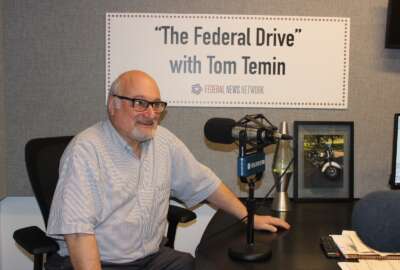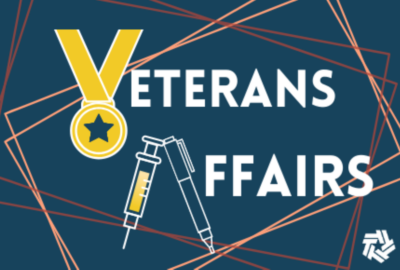
VA research award winner tries to ensure veterans receive equal care no matter who they are or where they live
The population of the nation's veterans has steadily grown more diverse — with respect to race and ethnic background — over the decades. And there are more...
The population of the nation’s veterans has steadily grown more diverse — with respect to race and ethnic background — over the decades. And there are more women than ever. Federal Drive with Tom Temin spoke with a woman who has done yeoman’s service to help the Veterans Health Administration not allow underserved and vulnerable veteran populations slip through the cracks. Dr. Donna Washington is the recipient of a recent VA secretary’s research award, and she’s a staff physician in the Greater Los Angeles Healthcare System.
Interview Transcript:
Tom Temin And I want to get a definition of terms underserved because the VA is everywhere. And does all this extensive reach out to veterans wherever they might be. So how does underserved come to this particular group of of health care seekers?
Donna Washington So I’m glad you asked that question. When you think about the term underserved in other contexts, meaning sort of the broader community outside of the VA, it often relates to lack of access to services. But within VA, financial barriers to health care access are minimized. Eligible veterans can use the VA without paying an insurance premium, for example. But despite that, there are groups both within as well as outside the VA that have historically experience greater barriers to achieving the highest level of patient experiences, health care quality and health outcomes. These are the groups that are underserved in a sense, outside the VA. Within the VA, it’s probably more accurate to think of these groups that are defined by race and ethnicity, by sex, by socioeconomic status, sexual orientation, mental health, disability, to name a few of the veteran population characteristics we’ve examined. It’s probably more correct to think of these groups as those that have been historically at risk.
Tom Temin Sure, you have done a lot of research in this area. And what are some of the conclusions you’ve found as to why this condition exists?
Donna Washington That answer requires an understanding of social determinants of health. When we look at the influences on health, health for groups served by the VA, health for groups in the community, then we find that medical care, though important, really just addresses a fraction of the health outcomes. Social determinants of health, meaning the conditions in which people are born, grow, work, live and age, and the wider set of forces and systems shaping the conditions of daily life have a much, much greater impact on health outcomes. And so despite having limited financial barriers to care, these social conditions are pervasive, and so they influence health outcomes of veterans served by VA.
Tom Temin And does this usually occur on racial lines, or is it more a matter of poverty? For example, a high percentage of the veteran suicides are white males, but they’re in rural areas where there’s not a lot of support. Maybe in urban areas would black veterans maybe have, I don’t know. There are certain public health conditions that affect black populations more than others. And they would be part of that milieu. Is that kind of what you’re saying?
Donna Washington So I’m saying it’s not an either or situation that when we look across different veteran characteristics, we see that it’s affected by some groups based on socioeconomic status, as you mentioned. So you mentioned, for example, white males in rural areas. Rurality or geography is important. And when you think about access to health care services, for example, then the existing community infrastructure may be less in rural areas. And so that’s a factor. Absolutely. race and ethnicity as well as sex within VA are important characteristics. And so these are all important characteristics. One of the major ways to evaluate and monitor health inequities or variations in health and health care within the VA that the Office of Health Equity has championed is periodically publishing a National Veteran Health Equity report. This provides the VA with information similar to that of the larger U.S. The U.S. as a whole has the National Quality and Health Disparities report that’s put out each year. When you look at the National Veterans Health Equity Report, you see that there are sections not only addressing socioeconomic status and race and ethnicity, but also rurality age and other factors, sex and other factors that define the different groups that are potentially at risk.
Tom Temin We’re speaking with Dr. Donna Washington. She’s a staff physician at VA’s Greater Los Angeles Health Care System and a recipient of a recent secretary’s award for research. And so therefore, the implication that you tell me, is that VA’s traditional one size fits all approach to delivering health care maybe needs to be tailored to different populations. A population health approach.
Donna Washington The VA has tailored it. I’ve seen in my research some good results because of that. So back when I started looking at differences in quality of care and outcomes within VA by race and ethnicity, what I identified early on is that there were differences, disparities, meaning meaningful decrements by race and ethnicity for both processes of care, meaning what’s done. So, for example, does someone with diabetes have an eye exam or have a foot exam when it’s due? We found early on differences in both processes of care as well as outcomes, meaning is their blood pressure controlled, is their diabetes controlled and so forth. And with the first quality transformation, the VA was able to systematically really sort of rightsize care so that there were systematic processes in care to assure that all veterans got the same recommended care. And what we found is that that disparities in processes of care closed, they narrowed or they closed. However, the disparities in some of these clinical outcomes that really are influenced both by health care as well as by social determinants of health persisted over time. More recently, some of the different interventions and clinical innovations that have been put into place address tailoring some of those social determinants of health. Let me give you an example.
Tom Temin I was going to say, let’s give us an example here.
Donna Washington The COVID-19 pandemic is probably fresh in all of our minds. And with the COVID-19 pandemic, the VA, as well as other health systems, was able to pivot to delivering telehealth services, meaning video as well as other ways of delivering care. But there’s something called a digital divide. Not everyone lives in a community with good broadband access. Not everyone could afford a laptop, a smartphone or other ways of connecting. And so the VA implemented a digital divide program in which they distributed broadband enabled tablets or phones to veterans at risk. So this is an example of tailoring care to address some of the social determinants of health so that all groups have the best possible chance of achieving optimal health outcomes.
Tom Temin Right. And I know VA went through a lot of effort to make sure that women veterans were treated in a way that could affect outcomes. I recall one story not too long ago actually, when in the last ten years or so, where simply turning examination chairs around so that they didn’t face the doorway to the hall was a way in which more women felt comfortable coming into VA for an examination.
Donna Washington Absolutely. The example that you just cited is part of looking at the physical plan. So when you think about the environment of care there, physical aspects of it, there are cultural aspects of it, there’s sensitivity. And the VA, based on data, based on studies that I’ve learned as well as others, identified where the areas were that needed improving and then systematically set out to create an environment of care and a culture of care that was welcoming and appropriate for women.
Tom Temin And what about the use of peer groups to encourage people to seek the care that they can get? Because different groups, different populations, have different places they tend to hang around. I know the Census Bureau, for example, uses very highly individualized channels of communication among different ethnic groups in a way to encourage people to respond to the Census poll every ten years. That kind of thing. Does it Does VA do that at all, or have you found that to be something effective?
Donna Washington Two questions embedded in there. First of all, peer groups are really crucially important. One example of the way that it’s used in VA are the peer support counselors. So peer groups have been studied. Peer counselors, it’s really the health system equivalent to community health workers as a way to help veterans navigate the system, help veterans talk to someone who could relate to their experiences because they’ve been through it, but also successfully identified ways to address some of the barriers faced. And so peer groups have been used. They have been studied. There are studies that have demonstrated their effectiveness, and I mentioned earlier, social determinants of health. One of the important social determinants is social support. And that’s really where peer groups can come in as a way to address that isolation and that need to have greater social support.
Tom Temin And what’s next on your research agenda, you personally?
Donna Washington I probably started with the easy hanging fruit when you look at health equity research and health disparities. It goes in generations, and much of my research sort of followed that path initially, identifying where disparities were so that we would know what areas to look at to intervene next, doing careful work, to understand what some of those underlying mechanisms are, and then addressing the easier things such as processes of care, looking further at social determinants of health, doing work to tailor care or to identify what forms of tailored care would help to address some of the social determinants of health. But now we’re left with sort of the thornier, more difficult to address issues, and that’s the underlying causes that we can’t see. So some of these so-called invisible contributors to disparities in health and health care by race, ethnicity by sex and by other population characteristics include some of the biases that are built into institutions structural barriers to care. It’s been termed different things, structural racism, even. And let me just give you a couple of examples.
Tom Temin Sure.
Donna Washington That has come to the attention of health systems over the last couple of years. With COVID-19 then it’s very it was very important, for example, to monitor oxygen levels. The health care systems use something called pulse oximeters, which measures the oxygen saturation of someone’s blood. It’s really a marker, for example, among those who were infected with COVID-19, how they might be impacted. And unbeknownst to many people, when pulse oximeter machines were developed, they were standardized on people who did not have dark skin. And so you could imagine that this is something that’s invisible to those of us who use these machines. The fact that they actually had different and potentially erroneous results in, let’s say, people with dark skin.
Tom Temin I didn’t realize skin color could affect oxygen levels in the blood.
Donna Washington Well, it doesn’t affect oxygen levels. What it effects is the ability of the machines to detect low levels.
Tom Temin And so because it’s a non-invasive type of thing, so it’s looking at you from the surface. In other words, the machine, it’s.
Donna Washington A non-invasive thing or I mean, there are other things here, algorithms, for example, how we measure kidney function. And so these are things that the best intentioned people don’t know that the machines may not be functioning the same way in different groups of people based on different characteristics. And so those are sort of the invisible contributors to differences in the ability to detect health issues and health outcomes. So addressing these structural barriers to care is really one of the next frontiers to sort of unraveling what some of the causes of these persistent disparities are.
Tom Temin And amidst all this research, you are a staff physician in a VA center. Do you ever get the time to lay a stethoscope on a chest once in a while, too?
Donna Washington Absolutely. It’s really important to me as a primary care provider that I maintain a continuity practice. So I continue to deliver care as a designated women’s health provider in the women’s clinic, as well as in the general primary care clinic. This is so important to me for so many reasons. One, it’s just so rewarding to be able to impact the health and help individual veterans achieve their health goals. Research takes a long time, whereas the feedback I get from patients each and every week is immediate. So that’s number one. But also the patients that I’ve had the privilege of caring for have inspired me and inspired some of the questions that I asked when I arrived at the VA. I actually was not a women’s health researcher, but delivering care in the women’s health clinic really helped me to understand what some of the issues were that my patients were struggling with, and that led me to design some of the research studies that then led to changes in health care and improvement in health care.
Copyright © 2025 Federal News Network. All rights reserved. This website is not intended for users located within the European Economic Area.
Tom Temin is host of the Federal Drive and has been providing insight on federal technology and management issues for more than 30 years.
Follow @tteminWFED
Related Stories

VA research award winner tries to ensure veterans receive equal care no matter who they are or where they live




